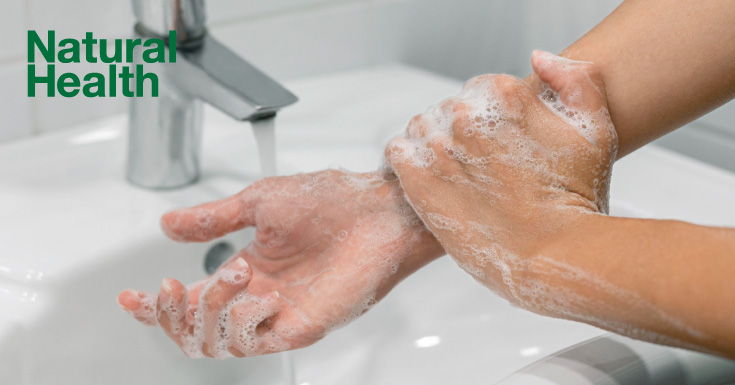Hand hygiene saves millions of lives every year and it is a smart investment now to close gaps in infection control and prevention as a lesson from the Covid-19 pandemic. Many diseases and conditions are spread by unwashed or dirty hands. Germs can enter the body via nose, eyes and mouth, and most people tend to touch their faces multiple times without realising it.
Keeping our hands clean is the most important step to avoid getting sick and spreading germs to others. It can reduce the number of people who get sick with gastrointestinal and respiratory illness such as diarrhoea, vomiting, cold and flu.
According to an article published by Centre of Disease Control and Prevention (CDC) in 2020, about 1.8 million of children under the age of 5 die every year due to diarrhoea and pneumonia, the top two killers of young children around the world. Therefore, regular handwashing with soap and water is one of the best ways to remove germs whether at home, at work, travelling or out in the community.
Germs and bacteria can get onto hands if people touch any surface or object that has germs on it because it was touched by another contaminated object or someone coughed or sneezed on it. Subsequently the germs from unwashed hands might contaminate foods and drinks then enter our body through the mouth. Contaminated hands also transfer those disease-causing organisms to objects like toys, table tops, handrails, door knobs and then transfer to another person’s hands upon touching it. Unknowingly, one can catch germs by a mere touch or handshake.
Other than that, faeces from humans or animals is another important source of germs like Salmonella and Escherichia Coli that cause diarrhoea and can spread respiratory infections such as adenovirus. They often get onto hands after people use the toilet or change diapers. A single gram of human poop may contain one trillion germs and it can be passed from one person to another subsequently making people sick simply because of poor hand hygiene.
Sometimes, we could get germs on our hands in a less expected way, such as handling raw meats that may have invisible traces of germs and bacteria on them. Handwashing with soap and water thus helps to remove germs and prevent gastrointestinal and respiratory infections among the community.
A number of infectious disease spread from one person to another by contaminated hands or unwashed hands. These diseases include gastrointestinal infections like salmonellosis and respiratory infections such as common cold, influenza as well as Covid-19. It is essentially important to wash our hands properly to remove germs like viruses and bacteria as some of these infections may lead to life threatening complications especially among young children, the elderly and those with a weakened immune system.
Even though many people clean their hands with water frequently but very few use soap while washing hands. Several studies have shown that proper handwashing using soap and water will remove disease-causing organisms more efficiently rather than washing hands with water alone.
Generally liquid soap is preferred compared to bar soap however bar soap is better than no soap at all. Alcohol based hand sanitisers are also very effective against most pathogens that are prone to get transmitted via hands. However, it is not so effective against gastrointestinal infections in which a better prevention is by washing hands with soap and water.
Proper hand hygiene plays an important role to curb further transmission of highly contagious viruses such as severe acute respiratory syndrome coronavirus-2 (SARS-CoV-2) and Covid-19, the causal pathogen of the ongoing pandemic.
Step by step guide on the correct technique for hand washing with soap and water:
“Wet, Get Soap, Scrub, Rinse, Dry”
- Remove any jewelleries from your hands.
- Turn on the water tap and wet your hands thoroughly.
- Use soap and lather very well for at least 20 seconds. Make sure to wash all of your fingers, between your fingers, under your fingernails, front and backs of your hands, wrists and forearms.
- Rinse thoroughly using clean running water and a circular rubbing motion to remove all soap residue on your hands.
- Dry your hands preferably with a single use paper towel or clean towel. **There may be concerns about using air dryers and its potential to spread germs via moving air.
- If possible, turn off the water tap with a paper towel and use the same paper towel to open the bathroom door (to protect your hands from touching dirty surfaces/ re-contaminate your hands).
When should we use hand sanitiser?
- If soap and water are not readily available, CDC recommends using a hand sanitiser with at least 60% alcohol to clean your hands. Then wash with soap and water as soon as you can.
- Do not use hand sanitiser if the hands are visibly dirty. For example, after gardening, playing outdoors, fishing, camping and cooking. Wash your hands with soap and water instead.
- Before and after visiting a relative or someone in a hospital or nursing home. Alcohol-based sanitizers is an effective sanitising technique unless the person is sick with Clostridiodes difficile (if so, recommended to use soap and water for hand washing).
- After blowing your nose, coughing or sneezing.
The right way to use hand sanitiser:
- Apply the sanitiser to the palm of one hand.
- Cover all surfaces of hands.
- Rub your hands and fingers together until they are dry. This will take around 20 seconds.
Safety tips when using an alcohol-based hand sanitiser:
- Do not rinse or wipe off the hand sanitiser before it’s dry.
- Keep the sanitiser out of your eyes because it can cause burning and damage the surface of the eyes. If you accidentally get sanitiser in your eyes, rinse your eyes thoroughly with water as soon as possible.
- Supervise young children especially toddlers using hand sanitiser because they may be attracted by pleasant smell and bright coloured bottles of hand sanitiser.
- Keep hand sanitiser away from heat and flames.
Tips for maintaining proper hand hygiene in various settings, such as at home, work and in public places
Current worldwide populations consist of different ages, occupations and lifestyle would prefer something in handy that can be accessed anytime and anywhere. Use of alcohol-based hand sanitiser is a faster and better tolerated method compared to washing hands with soap and water. It can kill most pathogens and one of the most preferred method to maintain hand hygiene in various settings.
Furthermore, alcohol-based hand sanitiser also does not create antibiotic-resistant superbugs. However, it is not effective when the hands are heavily contaminated with dirt, soils, blood or other organic materials. The sanitisers fail to kill Clostridium difficile, a bacterium that causes life threatening diarrhoea which has been identified as a common healthcare associated infection. Therefore, healthcare providers handling patients infected with this bacterium must wear gloves and wash hands properly with soap and water.
CDC recommends washing hands with soap and water as the best defence against germs. It is especially important to practise proper hand hygiene during these key times when you are likely to get and spread germs, such as:
- Before touching your eyes, nose, mouth or face.
- Before, during and after preparing food.
- Before and after eating food.
- Before and after caring for someone at home who is sick, especially those suffering from vomiting or diarrhoea.
- Before and after treating a cut or wound.
- After using the toilet or assisting a person when using the toilet.
- After changing diapers or cleaning up a child who has used the toilet.
- After blowing your nose, coughing or sneezing.
- After touching an animal, animal feed or animal waste.
- After handling pet food or pet treats.
- After touching garbage.
- Before preparing or taking medications.
- After touching a surface that is frequently touched by other people such as doors, gas pumps, payment machines, automated teller machines etc.
- After you have been in a public space or business.
- If your hands are visibly dirty and greasy.
When soap and water are not available, one alternative way is to use hand sanitisers or waterless hand scrubs. These products are usually made of ethyl alcohol mixed with emollients (skin softener) and other agents. Alcohol-based hand sanitisers should contain at least 60% of alcohol to be effective against some viruses like coronavirus. They are available in the form of gel, wipes or towelettes.
If you feel a cough or sneeze is coming, make sure to cough or sneeze into a tissue then throw it away and use the hand sanitiser. If tissue is not available, cough and sneeze into your elbow. It’s a part of the body that less likely to touch other surfaces and will help to stop the spread of nasty germs.
Despite the alternative options, soap and water is better and the best way to get rid of germs and bacteria. Hand sanitiser does not get rid of all types of germs and it may not be as effective when hands are visibly dirty or greasy. Hence, make sure to wash hands with soap and water as soon as possible.
Proper hand hygiene is the single most important, simplest and least expensive means of reducing the transmission of microorganisms (bacterias, viruses) and illnesses. Inappropriate hand hygiene has significantly spread harmful pathogens and affects many children around the world.
According to a report, one out of every three children who suffer from diarrheal and one out of every five children who are affected with respiratory illness eg. Pneumonia could be saved from catching the disease by washing hands properly with soap and water.Wearing gloves is not a substitute for hand washing as the contamination may occur during glove removal. In conclusion, washing hands with soap and water remains as the most effective method to remove germs on our hands.
Make hand hygiene a habit and practise it regularly. Remember, “CLEAN HANDS ARE SAFE HANDS”
Hand hygiene should be a part of educational priority. Proper hand hygiene behaviour shown by parents or adults plays an important factor as positive role modelling can help in improving adherence to hand hygiene among the young generations. Hand hygiene products should be readily available at all times for hand washing where necessary, whether at home, work, or in the car. You can help yourself and your loved ones stay healthy by a simple and easy practice – washing your hands properly and frequently!

Dr. Tania Peter Jang
Columbia Asia Hospital – Bintulu


